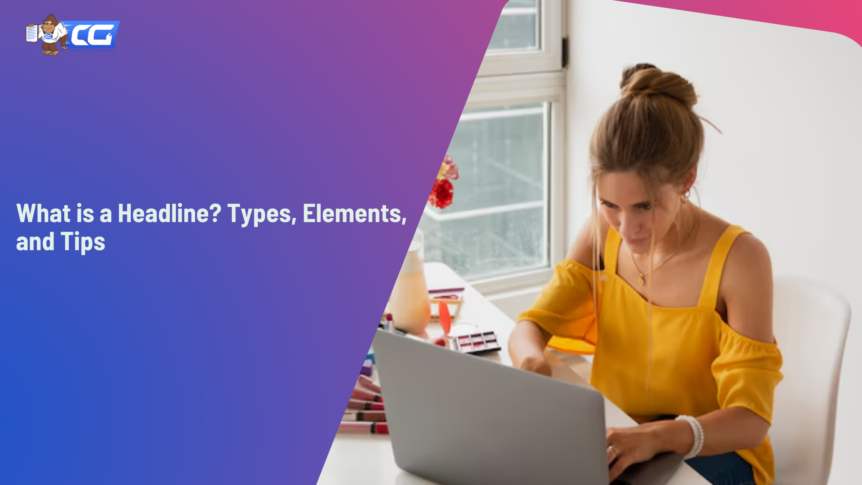Trust us; Google is not ignoring your content. It’s just searching for a headline that perfectly balances SEO requirements with compelling content. A headline for a blog is the first impression of your content on both readers and search engines. And that’s why understanding the art of its creation is essential for grabbing attention. So, what is a headline and why should you care?
Source: Content Gorilla
In this article, we’ll explore what a headline is exactly. We’ll further delve into the ins and outs of headlines, their types, elements, best practices, and tips to help you craft compelling headlines that grab attention and boost click-through rates.
Understanding What Is a Headline
No matter how well-crafted your content is, the fact is that 80% of your readers never get past the headline. It’s a deciding point for them to explore an article further. That means your headline carries the full weight of making a compelling first impression and hooking your audience to get to the meat of your content.
But what does “headline” mean? We won’t define it here in a run-of-the-mill way. Let’s keep it simple, easy, and interesting. A headline is a short, or rather very short, statement that summarizes the main idea of an article or a blog post in a few compelling words. It serves to capture the reader’s interest and encourage them to delve deeper into the full article.
Importance of a headline (H1 heading)
After understanding what a headline is, let’s explore why it’s important. Essentially, a well-optimized H1 heading:
- Improves search engine rankings and makes your content more discoverable.
- Helps structure and organize content, making it easier for readers to scan and understand the article’s main points.
- Encourages social media users to read and even share your content, boosting your online presence.
11 Types of Headlines You Should Know About
While discussing the topic of ‘what is a headline’, knowing their types cannot be left behind. Let’s explore different types of headlines below to reach your target audience effectively.
Direct Headline
It directly and straightforwardly states the idea of the main article. This type of headline is often used in news articles.
Example
Easy Vegan Recipes for Busy Weeknights
Salient Features
- To-the-point
- Quickly understandable
Indirect Headline
Unlike a direct headline, it creates curiosity by subtly hinting at what’s in the content. This is normally used for blog posts and ads.
Example
The Surprising Link Between Your Morning Routine & Mental Well-Being
Salient Features
- Open-ended
- Curiosity-driven
Benefit-Oriented Headline
It highlights the benefit (or value) readers will gain from reading your content. It’s mostly used in marketing and advertising campaigns.
Example
Effortless Baking: Delicious Recipes That Save You Time
Salient Features
- Benefit-focused
- Proposes value
Numerical Headline
It uses numbers to highlight the importance of certain points, facts, or statistics from within the content. Usually, articles or detailed guides leverage such headlines.
Example
5 Shocking Statistics About Climate Change
Salient Features
- Has quantifiable impact
- Grabs attention quickly
List Headline
A list headline differs from other types of headlines distinctly. It promises a specific number (of tips or ideas) and provides information in a list or a series format in a blog post or an article.
Example
10 Ways to Improve Your Writing Skills Quickly
Salient Features
- Promotes scanning
- Easy to digest
Question Headline
A question headline poses a question right away to pique curiosity. This is typically used in blog posts, articles, and opinion pieces.
Example
Is Your Diet Affecting Your Mood?
Salient Features
- Engages readers immediately
- Encourages clicks
How-To Headline
Such a headline offers a step-by-step guide to achieve specific results. Most probably, you’ll see this in instructional content, DIY blogs, and educational articles.
Example
How to Craft a Rustic DIY Headboard
Salient Features
- Provides Actionable advice
- Practical and clear
Reasons-Why Headline
This type of headline emphasizes a specific number of reasons supporting a particular viewpoint or course of action. It is ideal for persuasive articles or even listicles.
Example
7 Reasons Why You Should Drink More Water
Salient Features
- Persuasive
- Provides value
Command Headline
A command headline is a straightforward instruction or a call to action. It works effectively in direct response marketing and instructional content.
Example
Take Action Now: UN Warns We’re on “The Highway to Climate Hell’
Salient Features
- Direct and actionable
- Motivational tone
Emotional Headline
As the name implies, an emotional headline evokes emotions e.g. joy, sadness, or nostalgia using power words. This type is usually used in storytelling and personal blogging.
Example
The Ultimate Solution to Insomnia You’ve Been Searching For!
Salient Features
- Evokes emotion
- Creates a connection
Urgency Headline
This headline, as the name suggests, creates a sense of urgency or FOMO (fear of missing out). It is generally used in promotional content and time-sensitive offers.
Example
Don’t Miss Out: 5 Mood Boosters You Might Be Sleeping On
Salient Features
- Time-sensitive
- Compels action
Elements of a Powerful Headline
Let’s now discuss the key elements necessary to craft a perfect headline.
Clarity
A headline needs to be clear enough to ensure that a reader immediately understands what the content is about. Accordingly, it should avoid jargon and difficult terms. Professional blog writers keep their H1 titles’ wording simple and to the point which helps them convey the message quickly.
Brevity
Concise headlines are easy to read, understand, and even remember. In short, they have a greater impact as compared to long headlines. So, cut the fluff. Now the question arises of how long should a headline be. Keep it around 6-8 words for a total of under 65 characters.
Relevance
A headline must align with the content it introduces. It also shouldn’t be a clickbait title. When you make it relevant yet clear, it increases the likelihood of engagement. Furthermore, it helps you attract the ‘right’ audience, set clear expectations, and build trust.
Curiosity
It’s important to incorporate surprising elements in the headline to pique the reader’s curiosity. The best way is to use power words like Amazing, Best, Exclusive, and Now. Such words encourage readers to explore your content further by evoking emotions of excitement, joy, intrigue, or even sorrow — if the situation calls for it.
Specificity
Your headline should communicate clear insights into what the article offers. Include outcomes or even numbers that add credibility and appeal. And adding numbers in a headline always works! In fact, the earlier you add them, the better audience engagement you can expect.
Urgency
The headline should create a sense of immediacy, making the reader feel that the information or solution presented is time-sensitive or essential to their needs. This motivates them to act promptly. Use action-oriented phrases like now, today, urgent, limited time, etc.
How to Write Killer Headlines
In our all-inclusive guide on what is a headline, it’s time to discuss how to write a killer headline that gets a lot of clicks.
- Understand and speak to your audience in their language to make them feel connected.
- Focus on the context and clearly communicate the benefit or value of your content in the headline.
- Aim for impact with brevity by cutting the fluff because people have short attention spans.
- Include your focus keyword early in the headline to make it SEO-friendly. This ensures the most important information is front and center.
- Never write headlines only once. Use our Free Blog Post Idea Generator to craft a variety of headlines and test how they perform.
- Before finalizing a headline, use CoSchedule’s Headline Analyzer to check if it’s precise, SEO-friendly, and competitive.
[Bonus] Best Practices and Tips for Writing Headlines
Source: Giphy
Keep in mind the following unique tips for writing a compelling headline:
- Make use of 4C’s – Make your headline Clear, Concise, Compelling, and Creative. It helps you convey a message effectively and win more engagement.
- Use storytelling technique – Craft a headline that tells a story, using narrative elements to capture readers’ attention and imagination.
- Leverage the concept of alliteration – Create a memorable and catchy headline with repeating initial consonant sounds, making it more engaging and shareable.
- Incorporate industry-relevant lingo – Add industry-related terms, phrases, or acronyms that resonate with your target audience.
FAQs
Q. What’s the headline writing golden rule?
The golden rule of writing a headline is to make it clear, concise, and compelling to grab the reader’s attention immediately.
Q. What are the main functions of a headline?
A headline’s main functions are to grab attention, summarize content, and entice readers to read more.
Q. Does a headline impact SEO?
A headline impacts SEO by incorporating relevant keywords, improving click-through rates, and helping search engines understand the content of the page.
Q. Is it necessary to keep all headline words capitalized?
No, it’s not necessary to capitalize every word in a heading. Typically, a headline is written in the title case in which only the first letter of each word is capitalized.
Q. Should I end a headline with a period?
No, you should not end a headline with a period (.) as it can make it look less inviting to read.
Wrap Up
In this article, we discussed what is a headline, why it’s important, and how to write it by leveraging the best practices. Remember David Ogilvy’s advice: “On the average, five times as many people read the headline as read the body copy.” Thus, writing good headlines sets the bar of expectations for your article. It’s one and often only chance to stop the readers in their tracks and convince them the content is worth their valuable time.

I am a full-time online marketer, for over a decade now. Helped over 100,000+ people & generated well over $12M in online sales.

